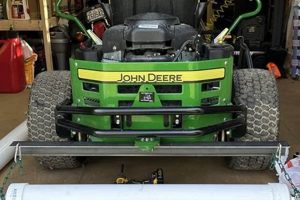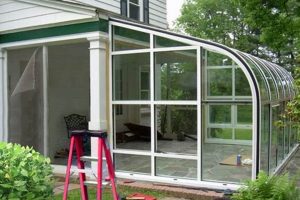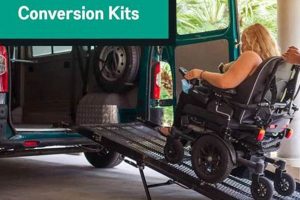A collection of components designed for individuals to assemble a computer numerical control (CNC) machine themselves. These sets typically include the mechanical structure, motors, control boards, and software required for operation. Assembled machines are capable of automated cutting, milling, and engraving of various materials according to pre-programmed instructions.
Building one’s own automated manufacturing device offers advantages such as cost savings compared to purchasing a pre-assembled unit. Furthermore, the assembly process provides in-depth knowledge of machine operation and maintenance, fostering self-sufficiency in troubleshooting and repairs. These offerings have gained popularity due to increased accessibility of open-source designs and readily available parts.
The following sections will delve into the key considerations for selecting appropriate components, the assembly process, required software, and potential applications. This includes a look at safety protocols to ensure secure machine operation and maintenance.
Essential Considerations for CNC Machine Kit Assembly
Successful construction and operation of a self-assembled automated cutting device necessitate careful planning and execution. The following tips offer guidance for individuals embarking on this project.
Tip 1: Component Selection: Prioritize quality components, particularly the linear motion system, spindle motor, and control board. Inadequate parts can lead to reduced precision and premature failure. Verify component specifications align with intended applications.
Tip 2: Frame Rigidity: The frame’s stability is paramount. Employ robust materials and proper assembly techniques to minimize vibration and deflection during operation. Consider reinforcing joints with gussets or brackets.
Tip 3: Wiring and Connections: Exercise diligence in wiring connections, ensuring secure terminations and proper grounding. Label all wires clearly for ease of troubleshooting and future maintenance. Use shielded cables to minimize electromagnetic interference.
Tip 4: Software Proficiency: Familiarize oneself with the chosen CAM (Computer-Aided Manufacturing) software and controller software. Practice generating toolpaths and simulating machine movements before attempting actual cuts. Understand the machine’s coordinate system and G-code commands.
Tip 5: Calibration and Tuning: Precise calibration of the machine axes is crucial for accurate results. Implement proper backlash compensation and PID (Proportional-Integral-Derivative) tuning for optimal motor control and smoothness of movement.
Tip 6: Safety Measures: Implement safety interlocks, emergency stop buttons, and appropriate guarding to protect oneself and others from potential hazards. Always wear safety glasses and follow recommended safety procedures.
Tip 7: Documentation and Support: Maintain detailed records of the assembly process, wiring diagrams, and software configurations. Utilize online forums and support communities for assistance with troubleshooting and addressing any issues that may arise.
Adhering to these guidelines will increase the likelihood of successful construction and operation, yielding a capable machine suitable for a range of projects.
The following sections will discuss specific applications and advanced techniques that can be employed with a custom-built automated cutting device.
1. Precision Components
The efficacy of a self-assembled automated manufacturing apparatus is intrinsically linked to the quality of its constituent parts. Selecting high-precision components is not merely a desirable attribute but a foundational requirement for achieving accurate and repeatable results.
- Linear Motion Systems
Linear rails and ball screws are critical for accurate axis movement. Higher-grade components exhibit tighter tolerances, resulting in reduced backlash and improved positioning accuracy. For example, using preloaded ball screws minimizes play in the system, directly translating to finer detail in the final product. Substituting these with less precise alternatives can result in noticeable inaccuracies and inconsistent performance.
- Spindle Accuracy
The spindle, responsible for holding and rotating cutting tools, demands high concentricity and minimal runout. A spindle with excessive runout will produce inaccurate cuts and uneven surface finishes. Precision-ground collets and balanced spindles are crucial for ensuring accurate tool placement and consistent material removal. This is especially critical when working with materials that demand tight tolerances.
- Control System Resolution
The control system, including the stepper or servo motors and associated drivers, dictates the machine’s ability to precisely position the cutting tool. Higher resolution motors and drivers allow for finer increments of movement, resulting in smoother curves and more detailed features. Selecting components with insufficient resolution can lead to a stepping effect, negatively impacting the quality of the finished product.
- Feedback Mechanisms
Implementing feedback mechanisms, such as rotary encoders on the motors, allows the control system to monitor the actual position of the axes and compensate for any errors or deviations. This closed-loop control significantly improves accuracy and repeatability, particularly in applications requiring precise dimensional control. Machines lacking feedback systems rely solely on open-loop control, making them more susceptible to inaccuracies caused by motor slippage or external forces.
The selection of precision components represents a significant investment that directly correlates to the performance and capabilities of a self-constructed device. While cost considerations are important, prioritizing quality in these critical areas is paramount for achieving optimal results and maximizing the potential of the completed machine.
2. Structural Rigidity
Structural rigidity is a cornerstone of performance for any computer numerical control machine, and its significance is amplified in the context of self-assembled units. The frame’s capacity to resist deformation under load directly affects machining accuracy, surface finish, and overall operational stability. Insufficient stiffness translates to vibrations, chatter, and inaccuracies in the final product. This necessitates careful consideration of material selection, frame design, and assembly techniques during the build process. For instance, a frame constructed from thin-walled aluminum profiles may exhibit excessive deflection compared to one fabricated from welded steel tubing. The former is more susceptible to vibration during heavy cuts, leading to poor surface finish and dimensional inaccuracies.
The choice of joining methods further influences overall stiffness. Bolted connections, while convenient, may introduce play over time if not properly tightened and maintained. Welded joints, on the other hand, provide a more rigid connection, but necessitate specialized equipment and skills. In the absence of welding capabilities, alternative joining methods such as epoxy bonding or the use of specialized fasteners can enhance joint stiffness. Furthermore, strategically placed gussets and braces can significantly reinforce critical areas of the frame, minimizing deflection under load. Consider, for example, reinforcing the gantry supports, which are particularly prone to flex during lateral movements.
In summary, structural rigidity is not merely a desirable attribute but a fundamental requirement for achieving predictable and accurate results with a self-assembled computerized numerical control device. The selection of materials, design of the frame, and execution of assembly techniques directly impact the machine’s ability to withstand cutting forces and maintain dimensional integrity. Prioritizing stiffness during the build process translates to improved machining performance, enhanced surface finish, and greater overall operational stability, leading to successful project outcomes.
3. Software Integration
Software integration forms a critical link in the operation of self-assembled automated manufacturing device. These machines are inherently reliant on software for both design and control, making seamless integration vital for realizing their intended functionality. The software suite typically encompasses Computer-Aided Design (CAD) for creating designs, Computer-Aided Manufacturing (CAM) for generating toolpaths, and control software for communicating instructions to the machine’s motors and actuators. A lack of proper integration between these components introduces bottlenecks in the workflow and compromises the accuracy and efficiency of the machining process. As an example, incompatibility between the CAM software’s output format and the control software’s accepted input would render the machine inoperable.
Practical application underscores the importance of selecting compatible software solutions. When constructing a device from a kit, one must ensure that the control board and associated software are designed to work harmoniously. Many kits are bundled with specific software packages, simplifying the integration process. However, individual component sourcing often requires careful vetting of software compatibility. For instance, LinuxCNC is an open-source control software known for its versatility, but it necessitates a suitable interface card and a compatible CAM program to function effectively. Similarly, Mach3 is a popular commercial option that demands careful configuration to match the specific motor drivers and encoders used in the machine. Furthermore, the selection of a post-processor within the CAM software is crucial for translating the generic toolpath into a machine-specific G-code program that the control software can interpret correctly. An incorrectly configured post-processor could result in incorrect machine movements and potential damage to the workpiece or the machine itself.
In conclusion, effective software integration is not a mere convenience but an indispensable requirement for realizing the potential of a self-built automated manufacturing setup. Selecting compatible CAD/CAM/control software, configuring the post-processor correctly, and ensuring seamless communication between the various software components are essential for achieving accurate and efficient machining results. Overlooking this aspect can lead to significant frustration and hinder the overall success of the project. Overcoming integration challenges often involves a deep understanding of G-code programming, control system configuration, and the specific requirements of each software package.
4. Motor Calibration
Motor calibration constitutes a pivotal process in realizing the intended performance of a self-assembled computerized numerical control machine. Precise control over motor behavior is paramount for accurate positioning, smooth motion, and ultimately, the quality of the machined part. Deviations from calibrated parameters can lead to dimensional inaccuracies, skipped steps, and undesirable vibrations, rendering the machine less effective.
- Step/Revolution Configuration
The steps per revolution parameter defines the number of discrete steps required for a motor to complete one full rotation. This value is contingent on the motor’s internal construction and the micro-stepping settings of the motor driver. Incorrect configuration of this parameter directly translates to inaccurate linear movement along the machine’s axes. For instance, if the steps per revolution are set too low, the machine will move less than intended for a given G-code command, resulting in undersized parts. Conversely, setting the value too high will cause overcompensation and oversized parts. This parameter must be precisely matched to the motor and driver configuration to ensure dimensional accuracy.
- Backlash Compensation
Backlash refers to the play or slop in the mechanical transmission system, typically present in lead screws or gearboxes. This play can manifest as a delay or jump when the motor reverses direction. Backlash compensation involves software-based techniques to counteract this effect by adding extra steps to the motor command when a change in direction is detected. Without proper backlash compensation, the machine will exhibit inconsistencies in positioning accuracy, particularly during intricate movements that involve frequent directional changes. Ignoring this factor leads to visible artifacts on the machined surface and compromised dimensional integrity.
- Acceleration and Jerk Settings
Acceleration and jerk settings govern the rate at which the motor’s speed changes. Aggressive acceleration settings can cause the motor to skip steps, especially under load, leading to lost position and inaccurate machining. Jerk, the rate of change of acceleration, impacts the smoothness of motion. High jerk values can induce vibrations and ringing, affecting surface finish. Optimal acceleration and jerk settings are a compromise between speed and smoothness, requiring careful tuning based on the machine’s mass, rigidity, and motor characteristics. Conservative values ensure reliable operation, while aggressive settings can improve machining time but may compromise accuracy.
- PID Tuning (Servo Motors)
For automated manufacturing devices employing servo motors, Proportional-Integral-Derivative (PID) tuning is essential for closed-loop control. PID controllers continuously monitor the motor’s actual position and adjust the motor command to minimize the difference between the desired and actual position. The proportional (P), integral (I), and derivative (D) gains determine the controller’s response to these errors. Improperly tuned PID gains can lead to oscillations, sluggish response, or instability. A systematic tuning process, often involving trial and error or automated tuning algorithms, is necessary to optimize the controller’s performance and achieve precise and stable motor control. This is critical for high-precision applications where minimal error is tolerated.
In summary, motor calibration is not a one-time setup procedure b
ut an ongoing process that necessitates periodic adjustments and refinements. Achieving optimal motor control hinges on meticulously configuring steps per revolution, compensating for backlash, tuning acceleration and jerk parameters, and, for servo-driven machines, finely adjusting PID gains. A calibrated motor system is directly proportional to the success of a self-constructed automated cutting device, assuring accuracy, minimizing errors, and producing high-quality finished parts. Therefore, paying careful attention to motor calibration throughout the machine’s life will positively impact the machine’s performance, reliability, and ultimately, its effectiveness.
5. Safety Interlocks
Safety interlocks are critical safety features integrated into machinery to prevent hazardous operations when specific conditions are not met. Their application is particularly pertinent in the context of self-assembled computerized numerical control devices, where standardized safety mechanisms may be absent and user expertise varies widely.
- Emergency Stop Buttons
Emergency stop (E-stop) buttons are prominent examples of safety interlocks, serving as readily accessible overrides to halt machine operation in the event of an anomaly or unsafe condition. Placement of multiple E-stop buttons around the machine is recommended to ensure accessibility from various operating positions. Activation of an E-stop should immediately cut power to all motors and actuators, preventing further movement and potential injury. In the context of a self-assembled device, the correct wiring and functionality of the E-stop system is paramount; a non-functional E-stop renders the machine inherently dangerous.
- Enclosure Interlocks
Enclosure interlocks prevent machine operation when safety guards or enclosures are open. These interlocks are typically implemented using limit switches or magnetic sensors that detect the presence of a closed guard. Opening a guard during operation should immediately halt the machine, preventing access to moving parts and ejected material. For self-built automated manufacturing devices, this often involves custom-fabricated enclosures with integrated interlock switches. Careful design and installation are crucial to ensure that the interlock functions reliably and prevents operation when the enclosure is not securely closed.
- Software Interlocks
Software interlocks implement safety checks and limits within the control software. These can include limits on axis travel, spindle speed, and tool selection. Exceeding a pre-defined limit should trigger an immediate halt to machine operation. For example, a software interlock can prevent the spindle from starting if the workpiece coordinate system has not been properly defined. In self-built machines, proper configuration of software interlocks requires a thorough understanding of the control software and careful definition of safe operating parameters.
- Coolant and Lubrication Monitoring
Interlocks can be tied to coolant and lubrication systems to ensure proper machine operation and prevent damage. For example, a sensor can monitor coolant level and prevent the spindle from starting if the level is too low, preventing overheating and tool damage. Similarly, sensors can monitor lubrication system pressure or flow to ensure adequate lubrication of bearings and lead screws. For custom-built units, integration of these monitoring systems requires careful selection of sensors and integration with the control system.
The integration of safety interlocks into self-assembled computerized numerical control machines significantly mitigates the inherent risks associated with automated machinery. While these mechanisms do not eliminate all potential hazards, their presence provides a crucial layer of protection for the operator and safeguards the machine from potential damage. Diligence in the design, implementation, and testing of safety interlocks is essential for responsible operation of self-constructed automated manufacturing equipment.
6. Application Versatility
The appeal of self-assembled automated cutting devices is strongly correlated with their inherent adaptability to a wide spectrum of applications. The fundamental architecture of these machines, coupled with user-defined component selection and software control, enables operation across diverse manufacturing processes and material types. This versatility constitutes a significant advantage over pre-configured, application-specific machinery, especially for hobbyists, small businesses, and educational institutions with varied project requirements. For instance, a machine built with a rigid frame and powerful spindle motor may be employed for milling aluminum components, while the same machine, equipped with a different cutting tool and adjusted software parameters, can engrave intricate designs on wood or acrylic. This adaptability reduces the need for multiple specialized machines, representing a cost-effective solution for many users. The capacity to handle diverse materials and processes hinges directly on careful component selection during the assembly phase. Choosing a versatile control system and implementing easily swappable tooling fixtures enhances the machine’s adaptability.
Consider the practical implications of this versatility in different domains. In the realm of prototyping, a self-assembled device facilitates rapid iteration and design refinement. A design engineer can quickly transition from machining a functional prototype from plastic to creating a more durable version from metal, all on the same machine. In education, the adaptability of these machines allows students to explore a wide range of manufacturing techniques and materials, fostering a deeper understanding of manufacturing processes. In small-scale production environments, a self-assembled device can be reconfigured to manufacture different products as demand fluctuates, providing a flexible and responsive manufacturing capability. This adaptability is not without challenges. Achieving optimal performance across diverse applications may require compromises in machine design and performance. For example, a machine optimized for cutting hard metals may not be ideal for delicate engraving on soft materials. Furthermore, users must possess the knowledge and skills to adapt the machine’s configuration and software parameters to each specific application.
In summary, application versatility is a driving force behind the popularity of self-assembled automated cutting devices. Their adaptability empowers users to tackle diverse projects and materials, making them a valuable asset in various fields. While optimizing a single machine for a broad spectrum of applications presents challenges, the inherent flexibility of these machines makes them a compelling choice for individuals and organizations seeking a cost-effective and adaptable manufacturing solution. The future development of this space likely includes greater focus on modular design, automated tool changing, and simplified software interfaces to further enhance their versatility and ease of use, increasing the practical application of these devices in diverse areas.
Frequently Asked Questions
The following addresses common inquiries regarding the construction and operation of user-assembled automated cutting devices, providing clarification on critical aspects.
Question
1: Are specialized skills required to assemble an automated manufacturing device from a kit?
While prior experience with electronics, mechanics, and software is beneficial, it is not strictly mandatory. Kits are designed with varying levels of complexity. However, successful assembly necessitates a meticulous approach, adherence to instructions, and a willingness to troubleshoot potential issues. Basic proficiency with hand tools and a comprehension of technical diagrams are essential.
Question 2: What is the typical timeframe for completing the assembly of a self-built computer numerical control machine?
The assembly duration varies significantly depending on the kit’s complexity, the assembler’s experience, and the availability of necessary tools. A simple kit may be completed within a weekend, while more intricate designs can require several weeks of dedicated effort. Careful planning, organization, and access to online resources can expedite the process.
Question 3: Is specialized software required for operating a self-assembled cutting device?
Operation necessitates Computer-Aided Manufacturing (CAM) software for generating toolpaths and control software for directing the machine’s movements. Some kits include bundled software, while others require separate purchase or utilization of open-source alternatives. Compatibility between the CAM software, control software, and the machine’s controller is crucial for proper functionality.
Question 4: What safety precautions should be observed during the operation of a self-built automated cutting device?
Safety should be paramount. Eye protection is essential to guard against flying debris. Enclosures or shielding should be used to contain ejected material and reduce noise. Emergency stop buttons should be readily accessible. The machine should be operated in a well-ventilated area to prevent inhalation of fumes or dust. Familiarization with the machine’s limitations and adherence to recommended operating procedures are crucial.
Question 5: How does the precision of a self-assembled machine compare to that of a commercially manufactured unit?
Precision is directly influenced by the quality of the components, the accuracy of the assembly process, and the effectiveness of calibration procedures. While it is possible to achieve comparable precision with a self-assembled machine, doing so requires meticulous attention to detail and a commitment to using high-quality components. Commercial units typically benefit from rigorous testing and quality control procedures, potentially resulting in higher levels of guaranteed precision.
Question 6: What are the primary limitations of self-assembled automated manufacturing devices?
Limitations often include a smaller work envelope compared to industrial machines, reduced rigidity in certain designs, and the potential for higher levels of vibration. Achieving the same level of automation and feature integration found in commercial units can be challenging. However, these limitations are often outweighed by the cost savings, customization possibilities, and educational benefits associated with self-assembly.
These frequently asked questions provide a baseline for understanding various features. Additional information is usually specific to individual models.
Subsequent sections will address advanced topics such as machine calibration and maintenance.
Conclusion
The exploration of computer numerical control machine self-assembly kits reveals a multifaceted landscape. Component selection, structural integrity, software integration, and motor calibration are pivotal determinants of machine performance. Safety interlocks mitigate operational hazards, while application versatility expands the machine’s utility across diverse projects. Successful navigation of these aspects dictates the realization of a functional and accurate automated manufacturing device.
The increasing accessibility of these components presents opportunities for innovation and customization within manufacturing environments. Continued refinement of design principles and simplified software interfaces will further democratize access to automated manufacturing capabilities, extending the potential impact of these kits across various sectors and applications.







